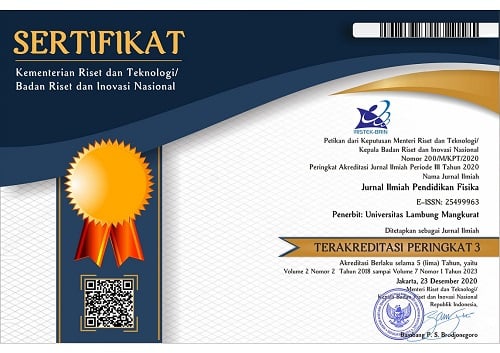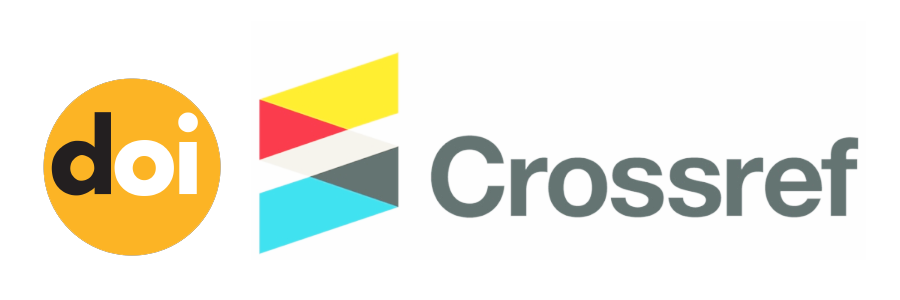Analysis of Students’ Creative Thinking Skills and Learning Motivation in Science Subjects at State Primary School
Abstract
Teachers have to offer learning opportunities that encourage the development of students, given the students’ relatively limited creative thinking skills and motivation to learn. This study aims to identify the categories of creative thinking skills and learning motivation exhibited by students in relation to each indicator within the field of electrical engineering. This study employed a quantitative descriptive approach, with a sample size of 27 students from 6 grades of SD Negeri Mangkang Kulon 02 Semarang in the 2023/2024 academic year. The data were obtained through the observation guidelines, questionnaires and document analysis, which the researchers meticulously prepared and developed. Based on the descriptive qualitative analysis, the overall rating for creative thinking skills was 68.94%, indicating a moderate level of proficiency. In the descriptive qualitative analysis, each creative thinking skills indicator achieved a maximum of 80.55%, which was classified as high, while the minimum was 60.19%, which was categorized as low. The overall motivation of the students was found to be 72.66%, which is classified as high motivation. The maximum percentage of students' motivation to learn was 79.26%, classified as high motivation, while the minimum percentage was 60.00%, considered sufficient motivation. The results of this study indicate that students at SD Negeri Mangkang Kulon 02 Semarang exhibit low levels of creative thinking skills and moderate levels of motivation in electrical engineering.
Keywords
Full Text:
PDFReferences
Aktas, M. C. (2016). Turkish high school teachers’ conceptions of creativity in mathematics. Journal of Education and Training Studies, 4(2), 42–52.
Al-Dulaimi, Z. Y. S. (2016). Education, educational services and their quality. Journal of Marketing Management, 4(1), 58–66.
Ambrose, D., & Sternberg, R. J. (2016). Creative intelligence in the 21st century grappling with enormous problems and huge opportunities. Rotterdam : Sense Publisher.
Ardiansyah, A. S., & Sunaringtyas, A. D. (2016). Identifikasi proses berpikir kreatif siswa dalam menyelesaikan masalah tipe multiple solution task. Prisma, Prosiding Seminar Nasional Matematika, 268–279.
Azis, N. A. (2018). Profil keterampilan berpikir kreatif siswa dalam memecahkan masalah matematika ditinjau dari kepribadian. Matematika Dan Pembelajaran, 6(2), 143–157.
Azzahra, I., Nurhasanah, A., & Hermawati, E. (2023). Implementasi kurikulum merdeka pada pembelajaran ipas di sdn 4 purwawinangun. Didaktik: Jurnal Ilmiah PGSD STKIP Subang, 9(2), 6230–6238.
Budiyono, B., Islam, H. S., & Siswanto, S. (2022). Open ended problems: Students’ creative thinking process on fluency indicators in terms of self-efficacy. AIP Conference Proceedings, 2566(1).
Chuang, Y.-T. (2014). Increasing learning motivation and student engagement through the technology-supported learning environment. Creative Education, 5(23), 1969.
Cigan, V. (2014). Relationship between students’ motivation and their socio-demographic characteristics. Linguistica, 54(1), 11–30.
Erduran, S. (2023). Social and institutional dimensions of science: The forgotten components of the science curriculum? In Science (Vol. 381, Issue 6659, p. eadk1509). American Association for the Advancement of Science.
Fakhirah, N. L., Darmiany, D., & Astria, F. P. (2023). Analisis kemampuan berpikir kreatif siswa pada mata pelajaran ipa kelas iv di sdn 36 cakranegara. Jurnal Ilmiah Profesi Pendidikan, 8(1b), 719–733.
Good, H. (2024). Unlocking creativity in education: Daydream believers. Childhood Education, 100(2), 20–27.
Hanaris, F. (2023). Peran guru dalam meningkatkan motivasi belajar siswa: Strategi dan pendekatan yang efektif. Jurnal Kajian Pendidikan Dan Psikologi, 1(1 Agustus), 1–11.
Henriksen, D. (2017). Creating STEAM with design thinking: Beyond STEM and arts integration. The STEAM Journal, 3(1), 11.
Kau, M. A. (2017). Peran guru dalam mengembangkan kreativitas anak sekolah dasar. Proceeding Seminar Dan Lokakarya Nasional Bimbingan Dan Konseling, 1(0), 157–166.
Kurnia, A. (2021). Profil kemampuan berpikir kreatif siswa menggunakan soal tes pilihan ganda pada pembelajaran Ilmu Pengetahuan Alam. Indonesian Journal of Educational Science (IJES), 4(1), 27–32.
Kuška, M., Trnka, R., Mana, J., & Nikolai, T. (2020). Emotional creativity: A meta-analysis and integrative review. Creativity Research Journal, 32(2), 151–160.
Liem, G. A. D., & Chua, C. S. (2021). Motivation in talent development of high-ability students: Research trends, practical implications, and future directions. In the Social and Emotional Development of Gifted
Children (pp. 173–189). Routledge.
Mahfud, M. (2017). Berpikir dalam belajar; membentuk karakter kreatif peserta didik. Al-Tarbawi Al-Haditsah: Jurnal Pendidikan Islam, 1(1).
McGarry, B. J., Theobald, K., Lewis, P. A., & Coyer, F. (2015). Flexible learning design in curriculum delivery promotes student engagement and develops metacognitive learners: An integrated review. Nurse Education Today, 35(9), 966–973.
Munandar, U. (2016). Pengembangan kreativitas anak berbakat. Jakarta : Rineka cipta.
MZ, A. F. S. A., Widiyanti, W., & Huda, M. M. (2024). Analisis keterampilan berpikir kreatif siswa pada mata pelajaran ipas kelas v sekolah dasar. Pendas: Jurnal Ilmiah Pendidikan Dasar, 9(1), 992–1001.
Ni’mah, A. (2022). Upaya guru dalam meningkatkan kreativitas berpikir peserta didik di sekolah dasar. Jurnal Penelitian Dan Pengembangan Pendidikan, 6(2), 173–179.
Nugroho, G. (2020). Analisis Motivasi Belajar Siswa Pada Pembelajaran IPA di SDN16/II Sepunggur. Integrated Science Education Journal, 1(2), 65–69.
Parke, M. R., Seo, M.-G., & Sherf, E. N. (2015). Regulating and facilitating: the role of emotional intelligence in maintaining and using positive affect for creativity. Journal of Applied Psychology, 100(3), 917.
Prayogi, A. G., Amry, Z., Matematika, P., & Medan, U. N. (2021). Pengaruh kemampuan berpikir kreatif dan kecerdasan emosional terhadap kemampuan pemecahan masalah matematik siswa di kelas viii mts al-jamiyatul washliyah tembung. Jurnal Fibonaci, 2(1), 38–41.
Priantini, D. A. M. M. O., Suarni, N. K., & Adnyana, I. K. S. (2022). Analisis kurikulum merdeka dan platform merdeka belajar untuk mewujudkan pendidikan yang berkualitas. Jurnal Penjaminan Mutu, 8(02), 238–244.
Putri, I. W. S., Hussen, S., & Adawiyah, R. (2017). Kemampuan berpikir kreatif dalam menyelesaikan masalah kesebangunan di smpn 11 jember. Jurnal Edukasi, 4(3), 59–62.
Rubenstein, L. D., Callan, G. L., Neumeister, K. S., Ridgley, L. M., & Finch, M. H. (2020). How problem identification strategies influence creativity outcomes. Contemporary Educational Psychology, 60, 101840.
Ryan, R. M., & Deci, E. L. (2018). Self-determination theory basic psychological needs in motivation, development, and wellness. New York : Guilford Publications.
Santoso, B. P., & Wulandari, F. E. (2020). Pengaruh pembelajaran berbasis proyek dipadu dengan metode pemecahan masalah pada keterampilan berpikir kreatif siswa dalam pembelajaran IPA. Journal of Banua Science Education, 1(1), 1–6.
Saregar, A., Cahyanti, U. N.,Misbah, M., Susilowati, N. E., Anugrah, A., & Muhammad, N. (2021). CORE learning model: Its effectiveness towards students' creative thinking. International Journal of Evaluation and Research in Education, 10(1), 35-41.
Sari, R. S., & Suhaili, N. Y. (2020). Bakat terhadap motivasi belajar siswa dalam proses belajar dan pembelajaran. Ensiklopedia of Journal, 3(1), 140–147.
Schunk, D. H., & DiBenedetto, M. K. (2020). Motivation and social cognitive theory. Contemporary Educational Psychology, 60, 101832.
Supriyono. (2023). Pengembangan pembelajaran ipa konsep listrik dinamis berbasis weblog berorientasi steam untuk meningkatkan kreativitas dan hasil belajar peserta didik [Tesis. Semarang : Program Magister Pendidikan IPA Universitas PGRI Semarang]. https://library.upgris.ac.id/digital/search?
keyword=STEAM&kdasar=judul&kjenis=&kjurusan=54&korder=kdesc
Suyidno, S., Susilowati, E., Arifuddin, M., Misbah, M., Sunarti, T., & Dwikoranto, D. (2019). Increasing students responsibility and scientific creativity through creative responsibility based learning. Jurnal Penelitian Fisika Dan Aplikasinya (JPFA), 9(2), 178-188.
Syamsurijal, S. (2023). Titik temu pendidikan dan pembangunan sumber daya manusia berdaya saing. Edu Cendikia: Jurnal Ilmiah Kependidikan, 3(03), 545–553.
Tapinos, E. (2016). The limitations impacting teachers’ understanding of creative thinking. Creative Education, 7(10), 1404–1409.
Tarsini, T., & Ningsih, T. (2021). Integrasi pembelajaran ips dan ipa kelas iv di madrasah ibtidaiyah pembina pengamalan agama (mi p2a) meri kutasari purbalingga. Jurnal Ilmiah Mandala Education, 7(3).
Umam, H. I., & Jiddiyyah, S. H. (2021). Pengaruh pembelajaran berbasis proyek terhadap keterampilan berpikir kreatif ilmiah sebagai salah satu keterampilan abad 21. Jurnal Basicedu, 5(1), 350–356.
Uno, H. B. (2023). Teori motivasi dan pengukurannya analisis di bidang pendidikan. PT. Bumi Aksara.
Vibulphol, J. (2016). Students’ motivation and learning and teachers’ motivational strategies in english classrooms in thailand. English Language Teaching, 9(4), 64–75.
Wafiqni, N., Amalia, S., & Sarifah, I. (2023). Hubungan lingkungan belajar dengan motivasi belajar siswa sekolah dasar. Ibtida’i: Jurnal Kependidikan Dasar, 10(1), 69–82.
Wahyuni, A., & Kurniawan, P. (2018). Hubungan kemampuan berpikir kreatif terhadap hasil belajar mahasiswa. Matematika: Jurnal Teori Dan Terapan Matematika, 17(2).
Wicaksono, A. B., Khabibah, S., & Masriyah, M. (2022). Konsepsi guru matematika sma tentang berpikir kreatif. Edumatica: Jurnal Pendidikan Matematika, 12(03), 249–255.
Yenti, Y., & Suaedi, S. (2022). Pengaruh kemampuan pemecahan masalah dan kecerdasan emosional terhadap kemampuan berpikir kreatif siswa. Proximal: Jurnal Penelitian Matematika Dan Pendidikan Matematika, 5(1), 91–97.
Zajda, J. (2018). Motivation in the classroom: Creating effective learning environments. Educational Practice and Theory, 40(2), 85–103.
DOI: https://doi.org/10.20527/jipf.v8i3.12772
Refbacks
- There are currently no refbacks.
Indexed by: Jurnal Ilmiah Pendidikan Fisika is licensed under a creative commons attribution-share alike 4.0 international license
Statistics Counter |
















